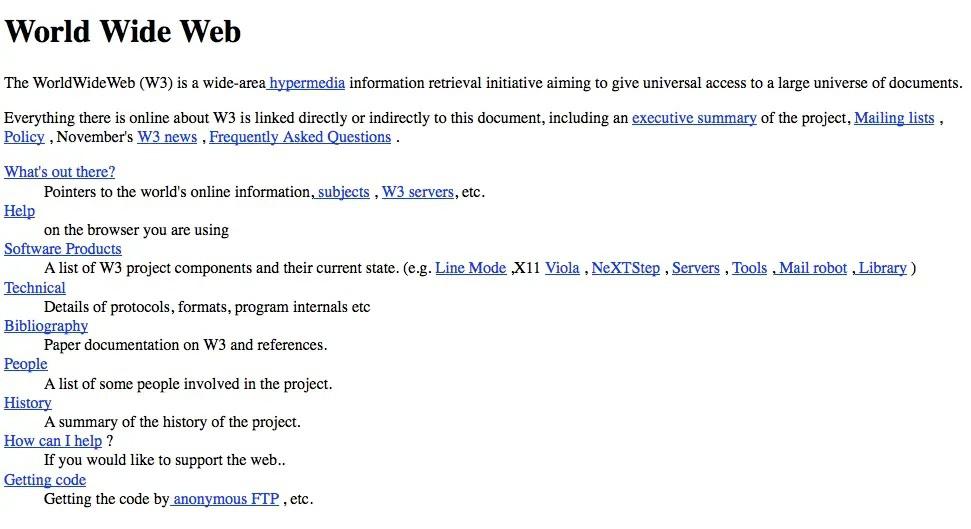The Role of a Web Designer


It’s 1991. Point Break is out in cinemas, Queen’s Bohemian Rhapsody is at the top of the charts, you can get a pint in your local for £1.20, and the average house price is £37,000 (yes, we’re weeping too). Simpler times, but crucially something that has changed the course of all our lives was in the making. On the 6th of August that year, the first-ever website went live…and the world of web design was born.

Image source: Info.cern.ch
Now looking at that page through a current-day lens, you’re undoubtedly…uninspired. But it goes to show quite how far the thought and technology behind web design and development has come.
Websites today are an experience in themselves. Enjoyable, attractive, and even inspiring. The right one can turn a humble product, brand, business, or experience into a key player in their respective industries.
Imagine selling a product in a brick-and-mortar shop. You’re going to do all you can to make sure that it looks clean, tidy, stylish, and professional, and that your customers can easily find the thing they’re looking for. You might brighten up the place with that Farrow & Ball paint you love, put up some cool art on the walls, and spend some time mapping out the floor plan in a way that ensures the customer can easily view your full range of products. The same sentiment stands in the online world and is where the role of a web designer has become so important.
With e-commerce at an all-time high (and rising), a website is now so much more than an informational page, or basic trading platform. It should excite, engage, and just be an all-around lovely experience for an audience.
Design is more important than ever. A recent Adobe study showed that when given only 15 minutes to consume content, 59% of global consumers craved beautiful design over simplicity, and 38% of people will leave a website if they find it unattractive. Harsh? Maybe! But with 1.7 billion websites currently active, and competition fiercer than ever, people won’t waste their time interacting with a site they find visually unappealing, and unenjoyable to use.
The facts of the matter are, that you can be offering a great service or product, and your website could technically be functional, but without intelligent design and an appealing aesthetic, many consumers won’t stick around (or even visit in the first place).
With new websites and applications popping up daily, and with the industry constantly evolving, any chance to cut through the noise should be grabbed with both hands.
First impressions count, and a skilled web designer can ensure that through eye-catching design and smart user-experience, a website makes the kind of long-lasting and positive impact it needs in an increasingly competitive digital world.
Web design in simplest terms refers to the designing of web pages that are made available on the internet. A combination of functional and aesthetic elements, web design is what controls the look of a website — such as its colour scheme and fonts —as well as shaping the site’s structure and the users’ experience of it. It is the art of effectively planning and arranging content to meet the needs of the user while ensuring the site provides an efficient and aesthetically pleasing experience from start to finish.
Web Designers are responsible for designing and building the interface, navigation, visual design and experiential aspects of a website, and while similar in areas, it is not to be confused with web development. Web development refers to the creation and maintenance of a website’s internal architecture and utilises complex coding languages to ensure optimal website functionality.
Learn more here about The Role of a Web Developer.
The aesthetics of a website directly impact a user’s opinion of the site and the company, and a web designer will work strategically to utilise design in a way that makes a website easy to use and navigate to achieve the desired result for the user. With 75% of consumers admitting to judging a brand’s credibility based on its website (and the experience they have with it), the strategic thinking a web designer brings to the team is worth its weight in gold for any business, big or small.
Consistency is often lauded as key, and that has never been truer than in the world of web design.
Familiarity is a huge part of building brand awareness and attracting customers to enjoy (and stay loyal to) your website and business. A web designer’s role is particularly important here as they work to create consistency across all pages of a site. A mishmash of fonts, layouts and styles at every click just looks plain messy, will deter customers, and essentially makes it impossible for you to build brand recognition as the user won’t know which colours and styles to associate with your brand.
Think of Coca-Cola as an example. Without even going to their website, in your mind you’ll be able to see the iconic red colour and font that’s intrinsically linked to their brand. Visiting their website, you’ll be instantly met with the visuals you’d expect, and this theme follows throughout.
This is not only fantastic branding, but smart web design, and the kind of project that would be second nature to any established web designer skilled in creating a memorable user experience.

Image source: Coca-cola.co.uk
User experience (UX) focuses on having a deep understanding of users, what they want, what they need, what they value, their typical behaviour, their abilities, and their limitations.
As technology has advanced and websites and web applications have become significantly more complex, what was once a static medium, is now a rich, interactive experience.
This is a wonderful thing, and websites are now able to do so much more and cater to so many, but this vast growth and development does come with its own pitfalls. This is where user experience comes into play.
While we’ve made astronomical advances, the core questions for any user remain the same. Am I finding what I want? Is it easy to get around? Is this an enjoyable experience? User experience design is all about ensuring that any visitor to a website answers yes to all of those questions and that the experience on any site is easy, efficient and relevant.
Good UX design takes into consideration each and every element involved that helps in shaping the experience for a user, how it makes them feel and how easy it is to fulfil the task/s they came to the website to complete.
Appearances are undeniably important, but a website design without consideration of UX is like a delicious-looking cake that’s dry and stale when you slice into it. Very, very disappointing (and bad business if you want to attract and retain customers).
While a web designer just starting out needn’t be an expert in the field of UX, it’s an important and valuable skill to have in today’s market, and a consideration of it will ensure that users get the most out of their beautiful designs.
In their day-to-day working life, a web designer will be mainly focused on several key elements of a website, and how to use design to ensure each aspect is considered and used to its full advantage.
These elements include:
A good web designer will be constantly considering these key elements when designing to ensure the effectiveness, attractiveness, and usability of every site they work on.
Utilising technical, analytical, and creative skills, a web designer’s daily responsibilities will also typically include these tasks:
Day-to-day activities when working in web design greatly can vary greatly, depending on whether you’re working in-house for a large company and within a team of designers, working alone as a freelancer and taking on specific projects for individual clients, or for a dedicated web design agency.
To learn more about working in a design agency read our articles What is a Web Design Agency? and How Do Web Design Agencies Work?
Web design is the perfect blend of creativity and technology, and any working designer will have mastered the technical skills needed to use a range of powerful design software applications to create visually appealing and easily accessible, and intuitive websites.
Professional web designers will make use of a range of primary programs including Figma, Sketch, Adobe XD, Wix and Weebly. Proficiency in using programming languages such as HTML, CSS and Javascript is a bonus, especially if you’re not working closely with web developers.
Skills in popular graphic design software such as Adobe InDesign, Photoshop and Illustrator are also advantageous.
Visit our article Which software is used in Web Design? to learn more about these dynamic web design tools, and how designers use them to create engaging websites.
Any working brand designer will also have:
Visit our article What Qualifications Do You Need to be a Web Designer? to see exactly what’s required to break into this fascinating (and burgeoning) industry.

Kirsty, in the MadeByShape Studio
The web design industry is worth £575 million in the UK, and its value has risen almost 4% a year since 2017. This is despite the pandemic — which has negatively impacted many industries— and demonstrates its continued development, its growing strength, and its ability to evolve.
The importance of having a strong and dependable online presence has greatly contributed to businesses needing the services of web designers to create or improve their company website.
In some areas, the need for design team members is higher than the number of designers available. Great news for anyone in, or hoping to get into, the industry.
Whether you arrive in the role via a design degree, boot camp or self-study, typical career progression can vary.
A traditional route would be starting in the industry as a web designer and advancing to a senior web designer role. The average salary for a web designer in the UK is £35,000 with senior web designers taking home £50,000 per year.
While a career in web design is no doubt a great option in the current climate, if a designer particularly enjoys the user experience side of their work, a career switch into UX design can be a smart transition.
Good web designers look to solve problems for their clients; UX designers look to solve problems for their users, web designers create engaging designs to elicit a positive response, whereas UX designers are concerned with eliciting emotions from users throughout their entire experience of using a product. Another consideration is that web design is tied to web browsers, whereas UX design is platform-independent — opening up many new areas of opportunity.
An average salary for a UX Designer in the UK is £47,000, and senior UX designers can expect to take home almost £60,000 a year. As the importance of user experience becomes more apparent, UX designers become even more invaluable, and they are now some of the most sought-after professionals in the world.
Other areas where an established web designer’s skills could be utilised include app design, game design and development, and multimedia programming.
Regardless of your journey into the role and career progression once there, and working in web design is an exciting and lucrative opportunity for anyone looking to combine a love of art and design with a futureproof area of technology.
Hello, I'm Natasia, and I'm a content writer for Shape.